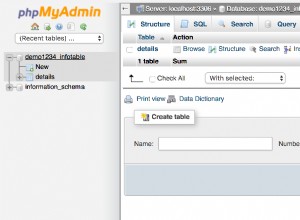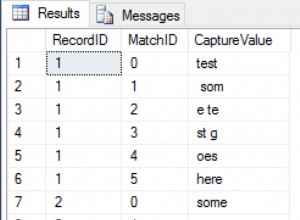Primero, antes de entrar en cómo obtener el Plan de ejecución real en el código y encontrar los que informan que necesitan índices, le recomendaría que consulte el uso de Asesor de ajuste del motor de base de datos (DTA) , puede alimentarlo con una lista de todas las consultas y las procesará diciéndole posibles índices, estadísticas y muchas otras cosas que pueden ayudarlo a planificar sus consultas.
Incluso mejor que darle una lista de más de 1 millón de consultas es que puede obtener un seguimiento del servidor con las consultas reales que se están ejecutando y se centrará en las consultas que toman la mayor parte del tiempo.
Para responder a su pregunta original, deberá agregar SET STATISTICS XML ON al comienzo de la conexión, esto le dará los datos XML en los que se basa la GUI que mostró. (Consulte aquí para obtener más información sobre cómo obtener el planes
). Una vez que haga eso, sus consultas regresarán con un conjunto de resultados adicional que contiene el xml para el plan en la primera fila de la primera columna.
Aquí hay una función rápida y sucia que hace eso.
private static string GetXmlPlanForQuery(string queryText)
{
string result = null;
using (var connection = new SqlConnection(connectionString))
using (var command = new SqlCommand())
{
connection.Open();
command.Connection = connection;
//Enable the statistics.
command.CommandText = "SET STATISTICS XML ON";
command.ExecuteNonQuery();
//Run through the query, keeping the first row first column of the last result set.
command.CommandText = queryText;
using (var reader = command.ExecuteReader())
{
object lastValue = null;
do
{
if (reader.Read())
{
lastValue = reader.GetValue(0);
}
} while (reader.NextResult());
if (lastValue != null)
{
result = lastValue as string;
}
}
}
return result;
}
Y aquí está el XML que devolvió para la consulta select TOTAL_SALES from clients where ACTIVE = 0; que ejecuté que tenía en una de mis bases de datos locales.
<?xml version="1.0"?>
<ShowPlanXML xmlns="http://schemas.microsoft.com/sqlserver/2004/07/showplan" Version="1.2" Build="11.0.5058.0">
<BatchSequence>
<Batch>
<Statements>
<StmtSimple StatementText="SELECT [TOTAL_SALES] FROM [clients] WHERE [ACTIVE][email protected]" StatementId="1" StatementCompId="1" StatementType="SELECT" RetrievedFromCache="false" StatementSubTreeCost="0.0767454" StatementEstRows="315" StatementOptmLevel="FULL" QueryHash="0x708AE72DD31A316" QueryPlanHash="0x214EA79FF76E6771" StatementOptmEarlyAbortReason="GoodEnoughPlanFound">
<StatementSetOptions QUOTED_IDENTIFIER="true" ARITHABORT="false" CONCAT_NULL_YIELDS_NULL="true" ANSI_NULLS="true" ANSI_PADDING="true" ANSI_WARNINGS="true" NUMERIC_ROUNDABORT="false"/>
<QueryPlan DegreeOfParallelism="1" CachedPlanSize="16" CompileTime="1" CompileCPU="1" CompileMemory="192">
<MissingIndexes>
<MissingIndexGroup Impact="94.0522">
<MissingIndex Database="[exampleDb]" Schema="[dbo]" Table="[CLIENTS]">
<ColumnGroup Usage="EQUALITY">
<Column Name="[ACTIVE]" ColumnId="15"/>
</ColumnGroup>
<ColumnGroup Usage="INCLUDE">
<Column Name="[TOTAL_SALES]" ColumnId="18"/>
</ColumnGroup>
</MissingIndex>
</MissingIndexGroup>
</MissingIndexes>
<MemoryGrantInfo SerialRequiredMemory="0" SerialDesiredMemory="0"/>
<OptimizerHardwareDependentProperties EstimatedAvailableMemoryGrant="830838" EstimatedPagesCached="207709" EstimatedAvailableDegreeOfParallelism="2"/>
<RelOp NodeId="0" PhysicalOp="Clustered Index Scan" LogicalOp="Clustered Index Scan" EstimateRows="315" EstimateIO="0.0749769" EstimateCPU="0.0017685" AvgRowSize="16" EstimatedTotalSubtreeCost="0.0767454" TableCardinality="1465" Parallel="0" EstimateRebinds="0" EstimateRewinds="0" EstimatedExecutionMode="Row">
<OutputList>
<ColumnReference Database="[exampleDb]" Schema="[dbo]" Table="[CLIENTS]" Column="TOTAL_SALES"/>
</OutputList>
<RunTimeInformation>
<RunTimeCountersPerThread Thread="0" ActualRows="315" ActualEndOfScans="1" ActualExecutions="1"/>
</RunTimeInformation>
<IndexScan Ordered="0" ForcedIndex="0" ForceScan="0" NoExpandHint="0">
<DefinedValues>
<DefinedValue>
<ColumnReference Database="[exampleDb]" Schema="[dbo]" Table="[CLIENTS]" Column="TOTAL_SALES"/>
</DefinedValue>
</DefinedValues>
<Object Database="[exampleDb]" Schema="[dbo]" Table="[CLIENTS]" Index="[imp_clpk_CLIENTS]" IndexKind="Clustered"/>
<Predicate>
<ScalarOperator ScalarString="[exampleDb].[dbo].[CLIENTS].[ACTIVE]=(0)">
<Compare CompareOp="EQ">
<ScalarOperator>
<Identifier>
<ColumnReference Database="[exampleDb]" Schema="[dbo]" Table="[CLIENTS]" Column="ACTIVE"/>
</Identifier>
</ScalarOperator>
<ScalarOperator>
<Const ConstValue="(0)"/>
</ScalarOperator>
</Compare>
</ScalarOperator>
</Predicate>
</IndexScan>
</RelOp>
<ParameterList>
<ColumnReference Column="@1" ParameterCompiledValue="(0)" ParameterRuntimeValue="(0)"/>
</ParameterList>
</QueryPlan>
</StmtSimple>
</Statements>
</Batch>
</BatchSequence>
</ShowPlanXML>
Ahora, debido a que Microsoft es muy bueno, si navega al espacio de nombres que se encuentra en el XML
en realidad puede obtener una copia de .xsd para el formato. Luego, desde el símbolo del sistema del desarrollador, puede hacer xsd showplanxml.xsd /classes y le dará un showplanxml.cs que puede usar con el XmlSerializer .
Aquí hay un pequeño programa de ejemplo que hace una interrupción del depurador en un índice faltante.
static void Main(string[] args)
{
string result = GetXmlPlanForQuery("select TOTAL_SALES from clients where ACTIVE = 0;");
XmlSerializer ser = new XmlSerializer(typeof(ShowPlanXML));
var plan = (ShowPlanXML)ser.Deserialize(new StringReader(result));
var missingIndexes =
plan.BatchSequence.SelectMany(x => x)
.SelectMany(x => x.Items)
.OfType<StmtSimpleType>()
.Select(x => x.QueryPlan)
.Where(x => x.MissingIndexes != null && x.MissingIndexes.Any());
foreach (var queryPlan in missingIndexes)
{
//This will hit for each statement in the query that was missing a index, check queryPlan.MissingIndexes to see the indexes that are missing.
Debugger.Break();
}
Console.WriteLine("Done");
Console.ReadLine();
}
Usé XmlSerializer y lo deseralicé en una clase, pero podrías cargarlo fácilmente en un XDocument y luego usar XPath
para encontrar todos los nodos llamados MissingIndex .




